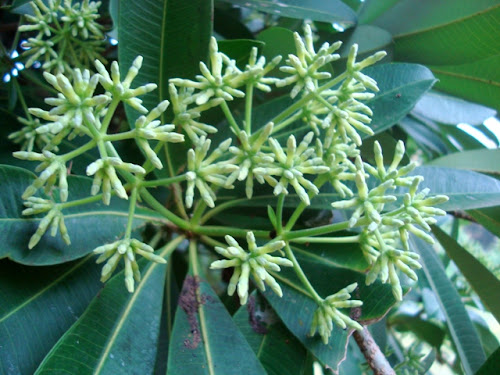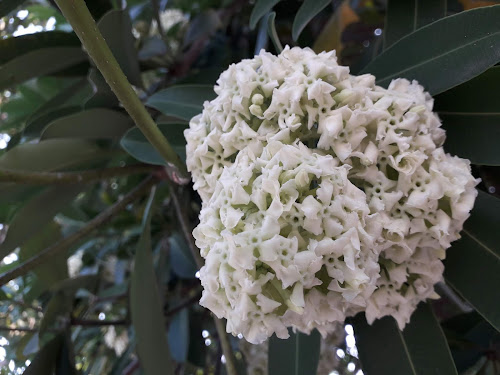Names of Chhatiana or Blackboard tree
Chhatiana is called Blackboard tree, Devil tree or Indian
devil tree, Ditabark, Palmira Alstonia, Milkwood, White Pine, Milky pine or Milkwood
pine, White cheesewood in
English. It is called
Shaitan ka jhar, Satvan, Chatiun, Chattiyan, Satni in Hindi, Chhatim or Chatnia in Bengali, Satiana or Sotiana in Asameses, Satvin
in Gujarati and Marathi, pala, Tirunamappalai, Captaparanam, Elilai-p-palai, Mukumpalai in Tamil, Devasurippi, Edakula-pala,
Elaramu, Pala-garuda in Telugu, Yakshipala, Daivappala , Elilampala, Kotapala, Mangalappala,
Mukkan-pala in Malayalam, Elelehale, Kodale, Mudihale, Pale, Bantale, Haale in
Kannada, Kashim in Urdu. In Sanskrit it is called Saptaparna,Vishala tvak, Vishamacchada,
Devavirshika, Bahuparna, Gandhiparna, Grahanasha, Guchhapushpa, Jivani,
Madagandha, Munichhada, Palagaruda, Shalmalipatraka, Sharadipushpa, and Suparnaka. In Oriya we
call it Chhatiana.
 |
| Bud of chhatiana |
The botanical name is Alstonia scholaris or Echites
scholaris or Pala scholaris. The tree has
got its generic name from the renowned 18th century botanist, Prof. C. Alston
of Edinburgh University. The specific name scholarisis derived from the traditional use of the wood for slates
or school boards in Myanmar.
 |
| Palmira Alstonia flower, |
Chhatiana is native
to the Indian subcontinent and Southeast Asia. It is evergreen. It is a tall tree that grows up to around 50 to 80 feet height with high, glabrous trunk. The bark is grayish. Branches are
whorled, and so are the leaves. The slightly rounded at the apex, leathery,
dark green leaves form whorls of 3-10. The upper side of the leaves is glossy, while the
underside is grayish. White funnel-shaped strongly perfumed flowers bloom in
the month October. The flowers are crowded, numerous, somewhat
hairy, and are a colour blend of white, cream and green; about 1
centimeter long, hairy in the throat. The seeds are oblong, with ciliated margins, and ends with
tufts of hairs 1.5–2 cm. The tree has regular branches and of a very symmetrical
shape. The bark and leaves produce a milky latex when injured, which is toxic. All parts of the tree can be considered poisonous.The bark is very
bitter in taste. Ditamine is a useful alkaloid obtained from this tree. That’s
why it is also called Ditabark. Leaves are generally found in the group of seven. That is
why it is called Saptaparni in
Sanskrit and some other Indian languages also because Sapta means seven and parni
means leaves. The fruition period is late winter season i.e. January to February.
It naturally grows in lowland rain forest
particularly in cyclone prone areas and is widely found in the countries of
India, China, Bangladesh, Sri Lanka, Thailand, Cambodia, Indonesia, Laos,
Malaysia, Myanmar, Nepal, Papua New Guinea, Philippines, Solomon Islands,
Vietnam and Australia. It is found in almost all parts
of India. It grows better under moist, warm climate but cannot stand water
logging. The wood is soft and suitable for pulp and paper production. The
timber is used for pattern making, packing, slates,
boxes, corks, blackboards,
coffins, core stock, plywood, carving and mouldings etc.
The tree is highly medicinal and is immensely valuable
from Ayurvedic point of view.
 |
| Chatnia Tree |
It is Anticancer, Antimicrobicidal, analgesic, febrifuge, stimulant, Antimalarial, antiamoebic, antidiarrheal, antihypertensive, hepato-protective, immune-modulatory, anti-asthmatic, anti-oxidant,
anti-inflammatory, anti-fertility, anti-diabetic, Anti-pyretic and
cardiotonic.
In Ayurveda the
bark and milk exudates is used solely for
medicinal purposes, ranging from Malaria and epilepsy to skin disorders and Asthma,
Foul Wounds, Sinus, Dyspepsia,
Urticaria, Bowel Complaints, Cough, Leprosy, Toothache, Rheumatism, and for upper
purification process of Panchakarma in
Ayurveda. The bark and latex is
considered tonic and antiseptic. The bark is used in chronic
diarrhoea and advanced stages of dysentery. It’s a blood purifier. The
Milky juice of the tree and the Poultice of
young leaves are applied to ulcers. A decoction of the leaves
is used for treating beriberi, dropsy and congested liver. The bark is used for making medicine in Homeopathy; In Homeopathy also it is particularly
useful for chronic diarrhoea and dysentery. In Ayurveda, infusion of bark soaked overnight is used in treatment of diabetes.
The bark serves as an alternative to quinine without its side effects. The bark
is also used as an antidote to snake bite.
N.B👉. All the above is solely for informational purpose and NOT INTENDED TO PROVIDE ANY KIND OF MEDICAL ADVICE. A REGD. AYURVEDIC/MEDICAL PRACTITIONER SHOULD ALWAYS BE CONSULTED FOR IT.